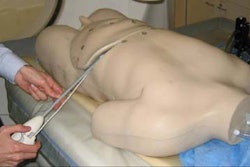SAN FRANCISCO - Discovering and diagnosing problems in the small bowel is hardly smooth sailing. Indirect imaging exams inside the bowels can be difficult to carry out, cause patient discomfort, and may outright miss small, mucosal, and flat lesions. Other techniques, such as intraoperative enteroscopy, are invasive, riskier, and more expensive.
The technology that is charting the right course for small bowel studies is capsule endoscopy (CE), according to a presentation Wednesday at the American Academy of Family Physicians (AAFP) meeting.
"The small bowel really has been the last unexplored viscus ... and we're off in search of a gold standard," said Dr. Steven Vogel, a family physician practicing in Rochester, MN.
Currently, only one capsule endoscopy camera (PillCam, Given Imaging, Yoqneam, Israel) -- also known as wireless CE, video CE, and telemetric gastrointestinal capsule imaging -- is approved for use in the U.S.
Vogel, and his co-presenter Dr. Ronald Sorenson, a gastroenterologist from Brainerd Medical Center in Brainerd, MN, offered their audience of primary care physicians a crash course on CE and how the technology can be incorporated into a general practice. They also discussed how CE was, on the whole, complementary to traditional imaging.
CE indications
Capsule endoscopy is particularly adept at pinpointing early-stage Crohn's disease, when changes are mostly mucosal. Early Crohn's disease cannot be caught with standard workup (inflammatory markers, x-ray, colonoscopy), but CE can help make the diagnosis in as many as 70% of patients, Vogel said.
Sorenson described a case of a 37-year-old woman with a family history of Crohn's disease. She presented with severe diarrhea and symptoms of irritable bowel disease (IBD). Her small bowel follow-through exam was normal, and her lab screen showed no inflammatory process. However, the CE exam revealed nodularity, loss of mucosal detail, submucosal ulcers, and inflammation for a diagnosis of active Crohn's disease.
"A few years ago, we would have had no way to get at that diagnosis," Sorenson said. "We saw the areas of cobblestone (nodules), we saw superficial ulcerations, we saw subepithelial hemorrhage, we saw findings that were consistent with Crohn's disease.... Capsule endoscopy shows us things that we haven't been able to see before."
Because most cases of obscure gastrointestinal bleeds (OGIB) arise from the sites in the small bowel, it makes sense that CE is becoming part of the standard workup protocol. The standard workup consists of colonoscopy, esophagogastroduodenoscopy (EGD), and a barium imaging study. But about 5% of OGIB remains undiagnosed even after this workup. CE is particularly adept at identifying the source of ongoing bleeding, particularly in the first 10 days.
Capsule endoscopy can also shed light on NSAID enteropathy. Patients on extended NSAID usage develop thin, circumferential strictures (diaphragms or webs) that cannot be identified on x-ray.
While small bowel tumors are not common, CE can spot them early enough to ensure faster treatment and a better outcome, the authors stated. Vogel noted that the cause of gastrointestinal bleeding in people younger than age 50 is most likely a tumor.
Finally, CE may prove to have advantages for tracking celiac disease, detecting villous changes and atrophy, finding parasites, and monitoring radiation enteritis.
Contraindications
Capsule endoscopy is not recommended in patients with known gastrointestinal obstructions, strictures, or fistulas. However, these issues can be circumvented with special procedures, such as placing the CE in the duodenum endoscopically, the presenters explained.
CE should also be avoided in patients who could not tolerate surgery or are about to undergo an MRI. The greatest risk associated with CE is a retained capsule, although this can be a blessing in disguise.
Sorenson described a case in which a 67-year-old woman presented with ongoing bleeding. Although she had a history of hematochezia and collagenous colitis, she did not complain of any pain or other symptoms. Her capsule got stuck in the small bowel, and Sorenson found that a friable, ulcerated hemorrhagic lesion in the distal ileum was to blame.
Two days later, the woman arrived at the emergency department with acute abdominal pain. A two-view x-ray and a follow-up CT revealed the capsule lodged in her small bowel. But it also revealed a heterogenous mass in the pelvis, which was ultimately diagnosed as ovarian carcinoma.
"We don't know how long she would have gone without symptoms," Sorenson said.
"(The capsule) getting stuck is not the worst thing," Vogel echoed. While retained capsules can be surgically removed, patients sometimes elect to leave them in as long as they are not causing discomfort, he said.
Imaging and CE
"(Imaging) and CE are complementary. It's not one or the other," Vogel said. If obstruction is a concern, the best pre-CE test is CT enteroclysis. Obstruction of the capsule in Crohn's disease can be a barrier to CE, but the exam may proceed if the patient has no signs of obstruction on a small bowel follow-through x-ray exam, Sorenson said. Vogel added that patients with prestenotic dilatation are unlikely to properly pass the capsule and would benefit from another type of test.
Vogel also said that x-ray and ultrasound are complementary for evaluating the bowel wall and searching for fistulas, masses, and abscesses. While CE may pick up lesions in the colon, it cannot replace colonoscopy (a common query that Vogel said he received from patients).
Sorenson offered an example of a case in which CE and imaging worked in concert. He described a 76-year-old male with severe diarrhea, abdominal pain, and excessive gas. The patient had a history of Crohn's disease and small bowel lymphoma, as well as progressive anemia. He was on steroid therapy.
Abdominal CT and small bowel x-ray showed no obstruction, so Sorenson proceeded with CE. The latter showed thickening and redness in the distal ileum. He went on to colonoscopy, which revealed a cytomegalovirus (CMV) inclusion. The final diagnosis was Crohn's disease complication with CMV inclusion, enteritis, and colitis, Sorenson said.
Vogel directed the audience to several published articles that have compared CE to barium small bowel exams, CT, and MR enteroclysis (Abdominal Imaging, March-April 2005, Vol. 30:2, pp. 179-183; RadioGraphics, May-June 2005, Vol. 25:3, pp. 697-711; Radiology, January 2004, Vol. 230:1, pp. 260-265; RadioGraphics, October 2001, supplement no. 21, pp. S161-S172).
Patients and payment
Word of mouth about the relative comfort level associated with CE has made some patients particularly primed for the procedure. "Patients don't like having some of the other tests that we give them. They do prefer (CE) by a large margin. Getting patients to say, 'I'll have that EGD done or that colonoscopy' is not always easy," Vogel said.
Of course, there are some caveats. Patients need to understand that small bowel CE is not a screening test, Vogel stressed, and is sometimes best used in conjunction with other exams, leaving a patient to decide how many tests he or she is willing to endure. And as with those other exams, patient preparation is important. That may include fasting or stopping other medications for at least a week before CE.
Reimbursement for CE is coming along. Medicare and Blue Cross Blue Shield (of Minnesota) will cover CE for OGIB and Crohn's disease, Vogel said. (For a list of payors compiled by Given Imaging, click here.)
As with any new technology, CE does require capital outlay. Sorenson estimated that a total CE exam will run about $1,000, which is similar to a colonoscopy. Medicare payment for reading a CE exam is around $180, he said.
Each single-use capsule is approximately $450, but the real investment is the equipment, which may require a $25,000 investment. The presenters urged attendees to look at it as a worthwhile one. "We need to know what's in the best interest of our patients. We not only have more scope (with CE), we have more detail," Vogel said. "CE can change clinical decisions."
By Shalmali Pal
AuntMinnie.com staff writer
September 30, 2005
Related Reading
Video capsule endoscopy does not seem to interfere with implanted defibrillators, August 31, 2005
Given posts mixed results for Q2, July 29, 2005
Humana revises capsule endoscopy policy, May 19, 2005
Video capsule shows Crohn's small bowel lesions more accurately than CT, February 8, 2005
Copyright © 2005 AuntMinnie.com



















